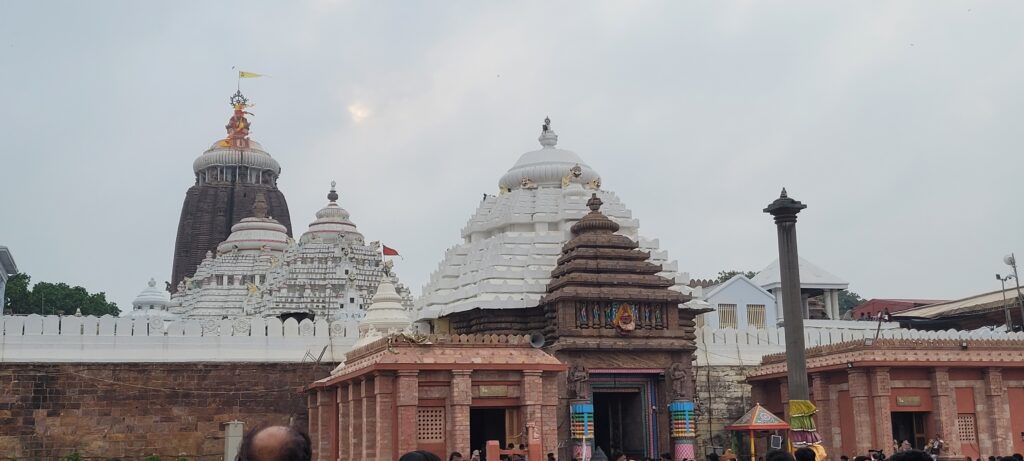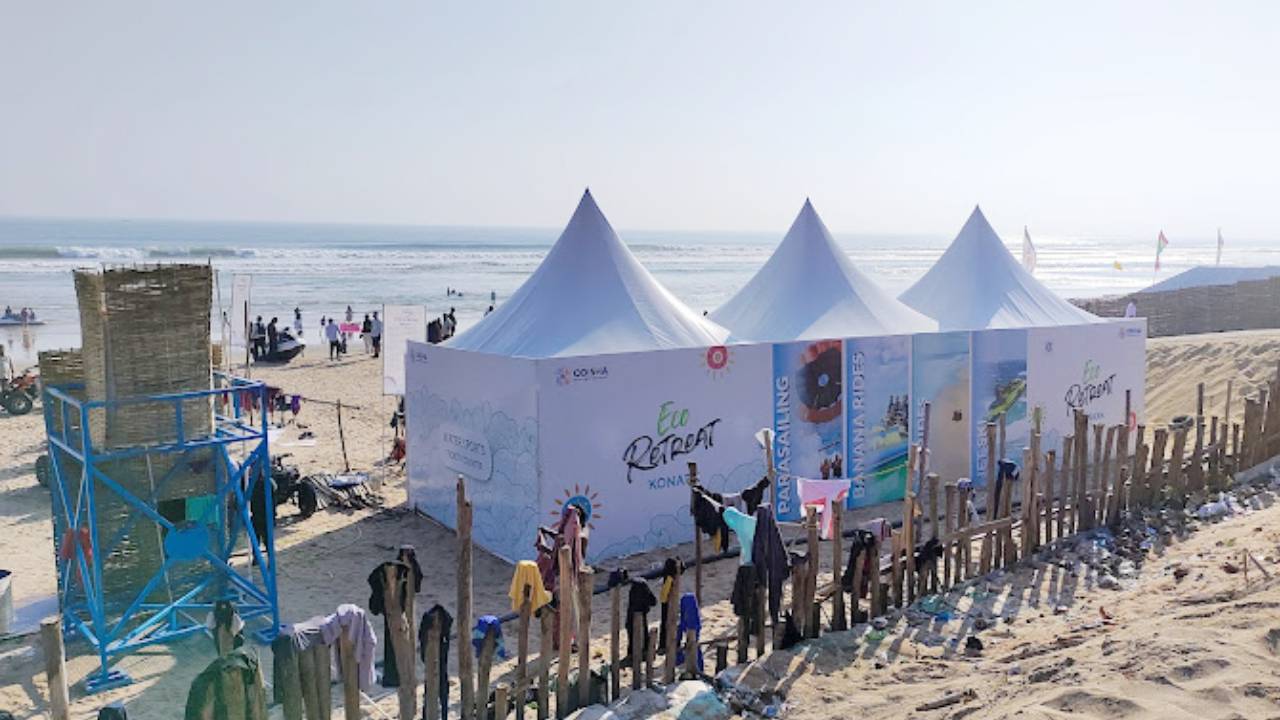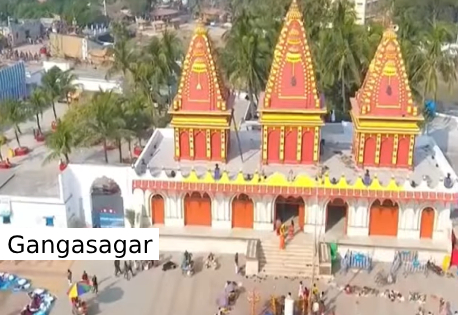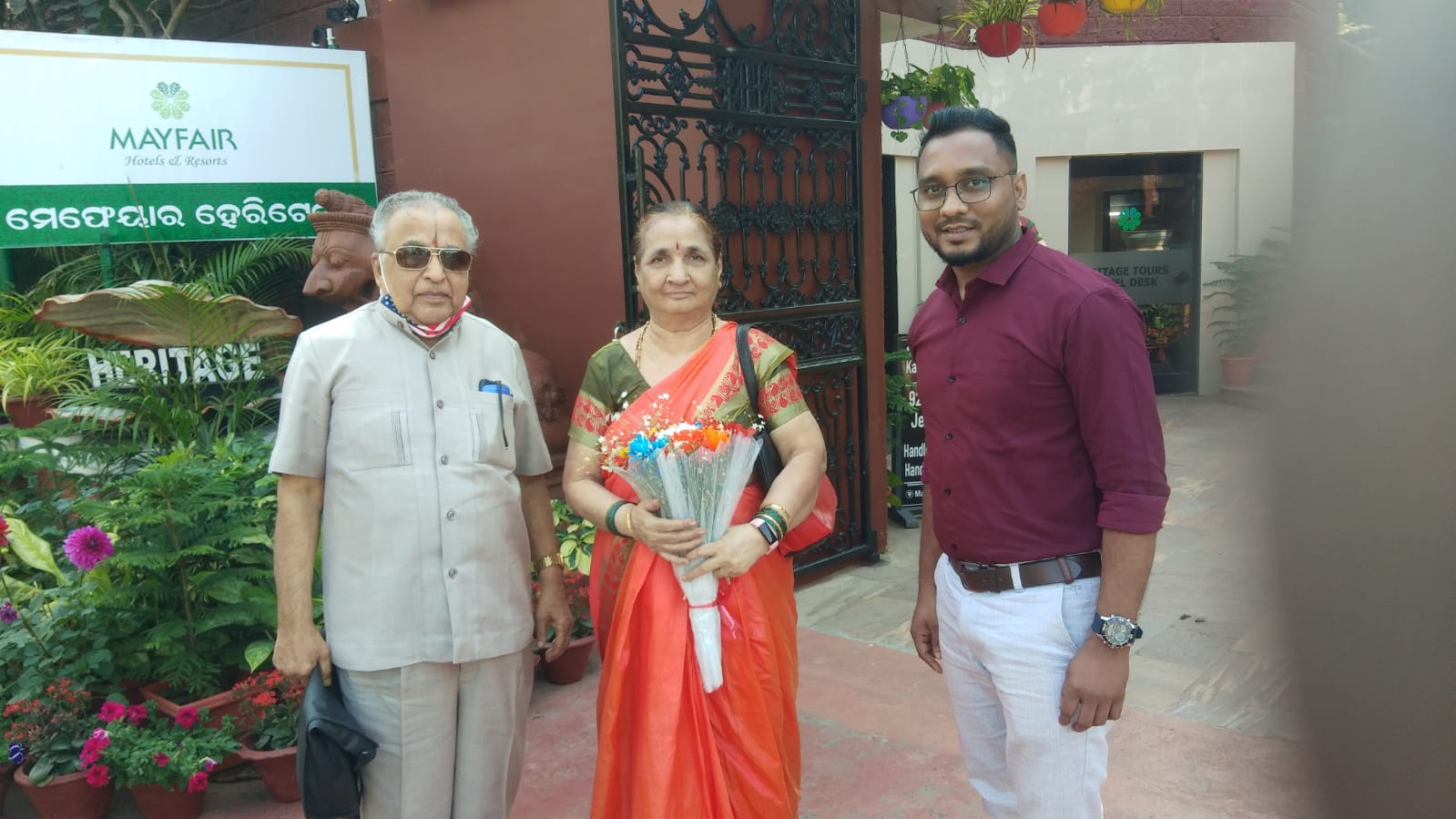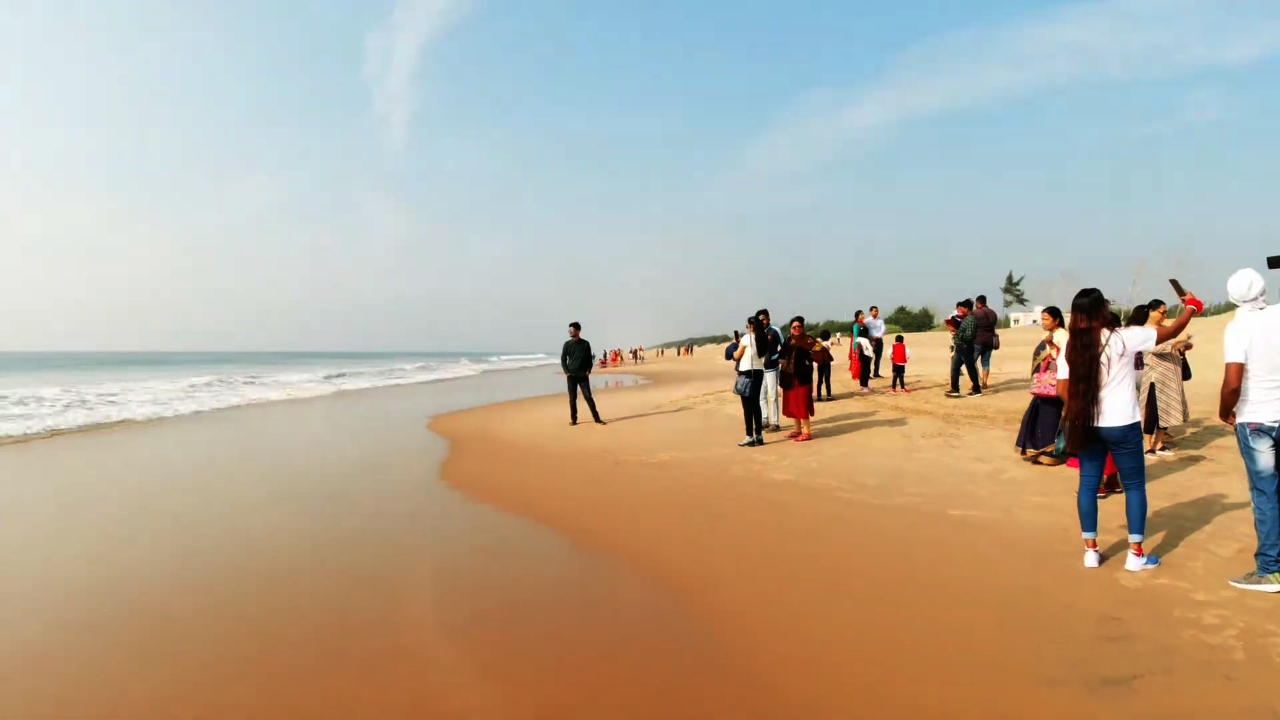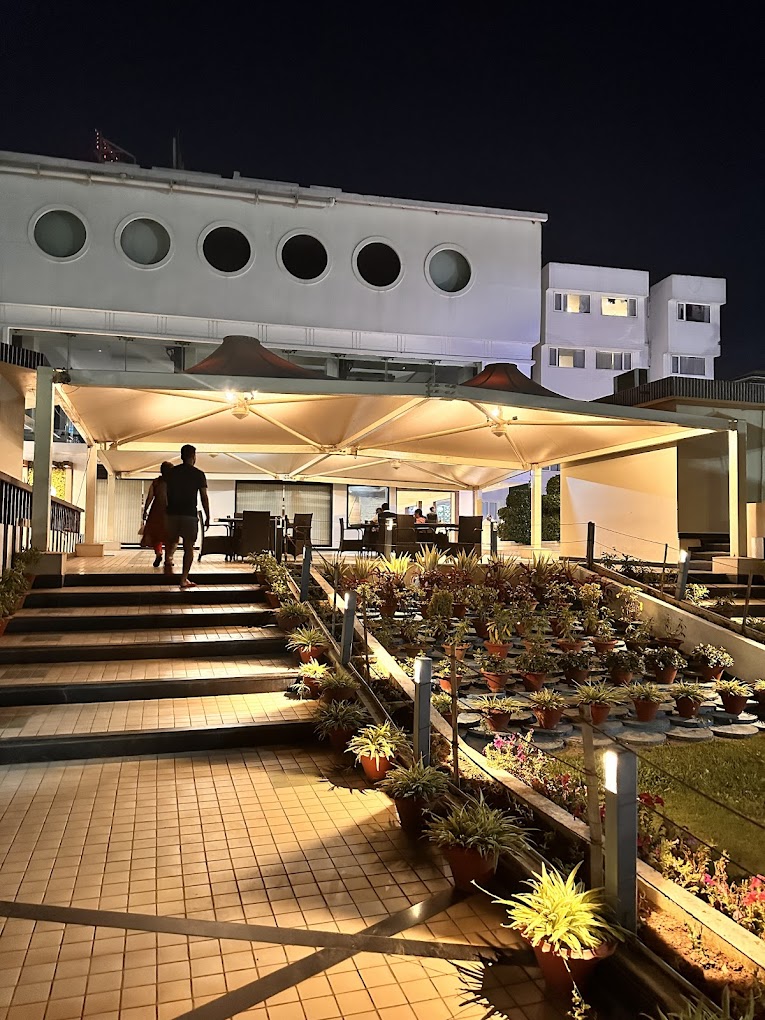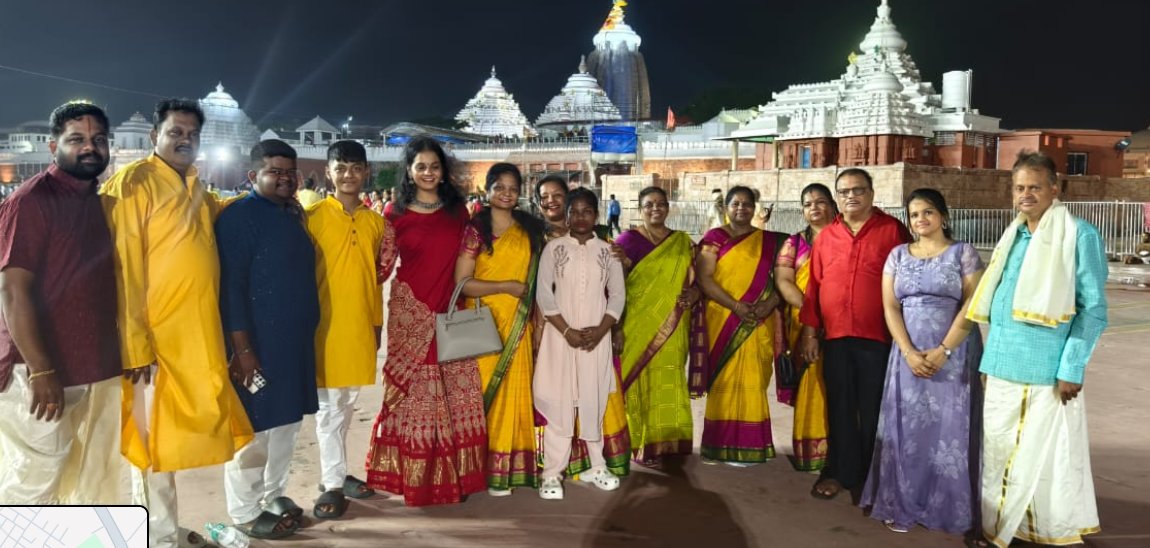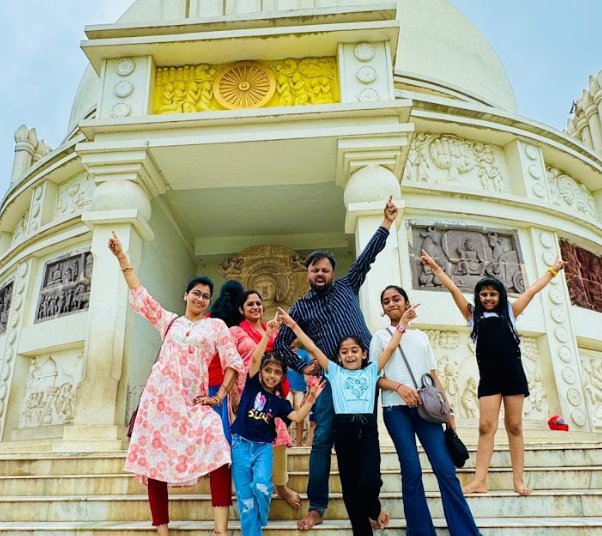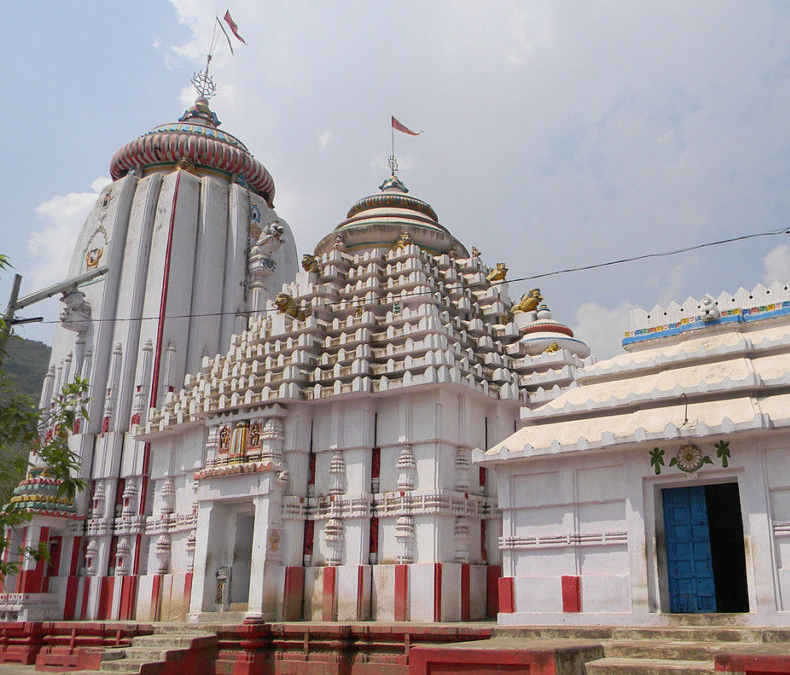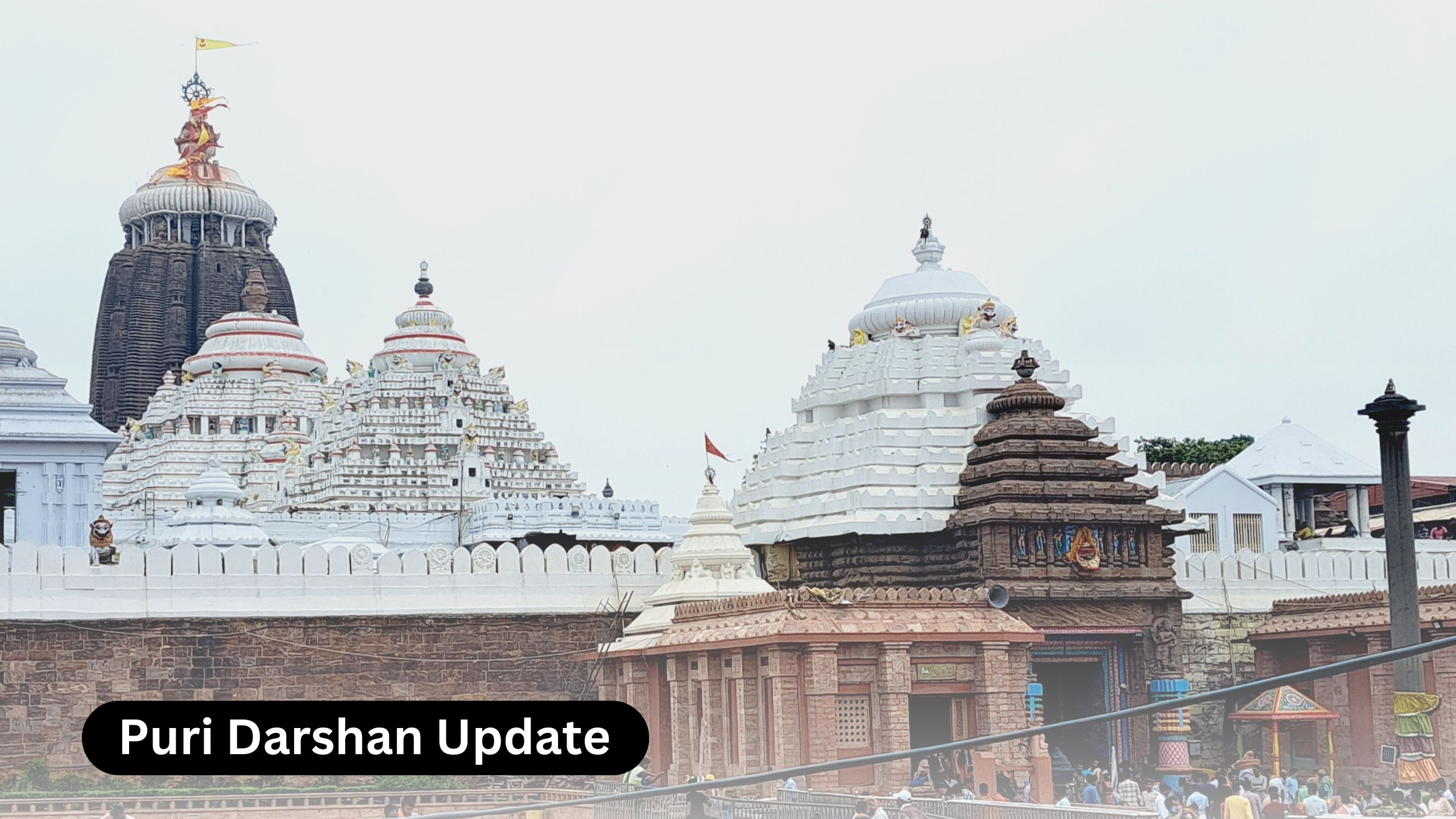About Jagannath Temple
Shree Jagannath Temple in Puri, one of the four sacred dhams of India, stands majestically in the ancient city of Puri, Odisha. Temple is dedicated to Lord Jagannath, a form of Lord Vishnu known as the Lord of the Universe. Each year, millions of devotees flock to this holy site, with numbers soaring during the renowned Rath Yatra festival.
Built in the distinctive Kalinga architectural style, the temple complex includes several smaller shrines alongside the main temple, each with its own fascinating stories. Primary deities worshipped here are Lord Jagannath, his brother Lord Balabhadra, and his sister Goddess Subhadra. Temple’s architecture is truly remarkable, showcasing the exquisite craftsmanship of the ancient era, particularly evident in its historic gates.
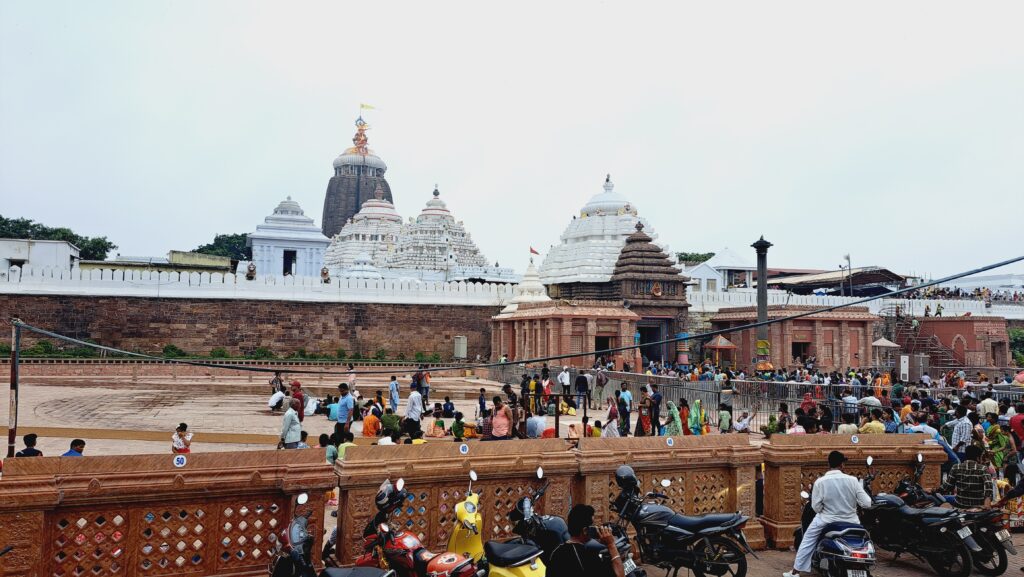
History of Jagannath Temple
According to folklore, before being revered as Jagannath (Lord of the Universe), the deity was worshipped as ‘Purushottama’ – the supreme being who is the creator, protector, and destroyer of the world. Current structure of the Shree Jagannath Temple in Puri is believed to have been initiated by King Ananta Varman Chodaganga Deva, the founder of the Ganga Dynasty, in the 12th century AD. Temple was completed in 1230 AD under the reign of Anangbheema Deva III, who also consecrated the deities within the shrine.
Nabakalebara
Nabakalebara is a unique and sacred tradition of the Jagannath Temple, performed periodically every 8, 11, 12, or 19 years. Term ‘Nabakalebara’ translates to ‘new embodiment,’ reflecting the ritual’s purpose of renewing the wooden idols of the deities based on specific astrological and astronomical calculations.
Intricate process involves 12 steps, starting with a journey to a forest to find the divine trees. Selected trees are then cut and shaped into new idols. Newly crafted idols are brought to Puri, where they replace the old ones, which are ceremonially buried. New idols are then revealed to the devotees, marking the culmination of this profound tradition.
Jagannath Temple Festivals
Shree Jagannath Temple celebrates around 12 major festivals with immense fervor, collectively known as ‘Dvadasa Yatras’. Significant festivals include Snana Yatra, Sayana Yatra, Parshwa Parivartana, Deva Utthapana, Daksinayana, Pushyavisheka, Pravarana Sasthi, Dola Yatra, Makar Sankranti, Chandana Yatra, Akshaya Tritiya, Damanaka Chaturdashi, and Neeladri Mahodaya. Each festival is marked by unique rituals and traditions, adding to the temple’s vibrant cultural and spiritual tapestry.
Rath Yatra
One of the most important celebrations at the Jagannath Temple in Puri is the famous Rath Yatra festival. Thousands of devotees throng to Puri each year to witness this grand celebration. Festival is celebrated on the second day of the Asadha month (as per the Hindu calendar). For this Chariot Festival, three chariots are constructed each year.
To the major festivals, the Shree Jagannath Temple also celebrates a variety of other significant festivals with great enthusiasm. These include Shree Krushna Janma, Jhulan Yatra, Ganesh Chaturthi, Balabhadra Janma, Saptapuri Amabasya, Rahurekha Lagi, Badi Nrusimha Bije, Chitlagi Amabasya, Rishi Panchami, Holi, Ramnavami, and many others. Each of these festivals brings its own unique rituals and joyous celebrations, enriching the spiritual and cultural life of the temple.
Jagannath Temple Puri Photos
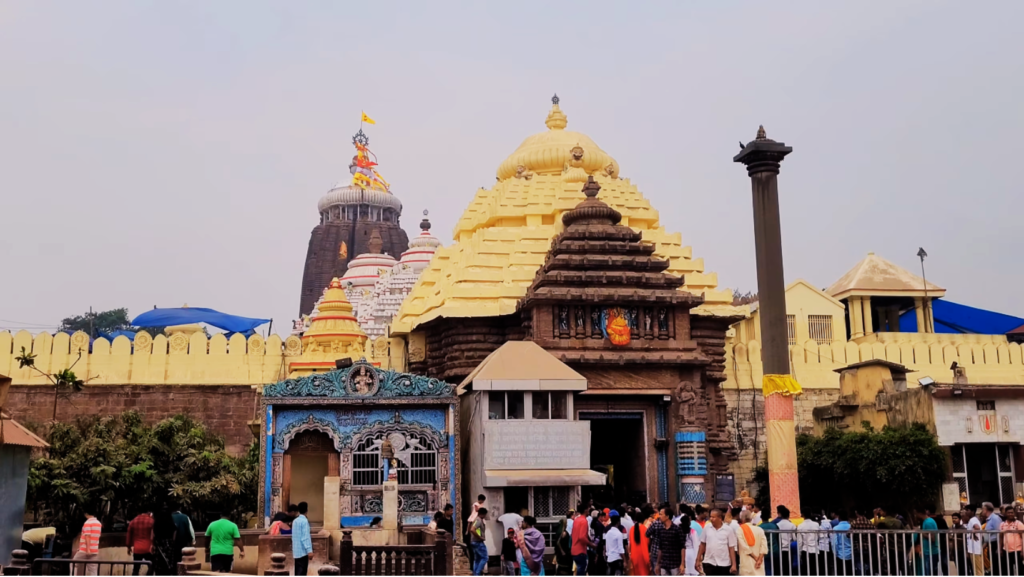
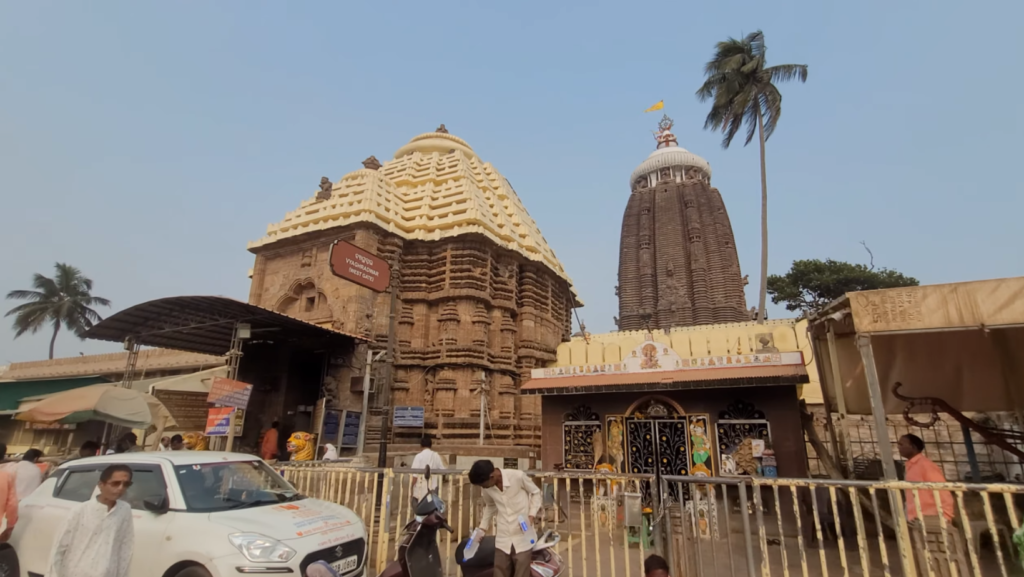
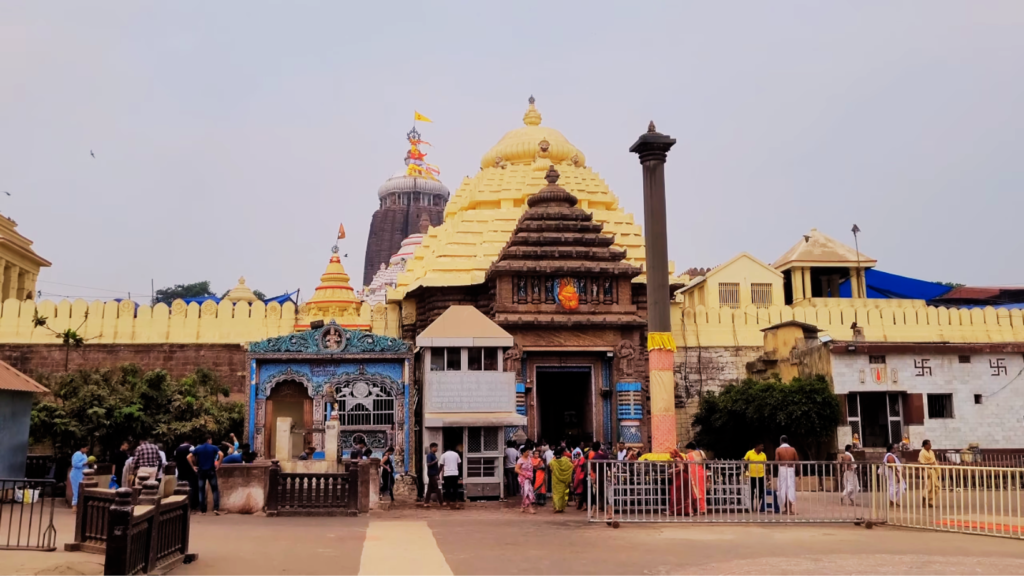
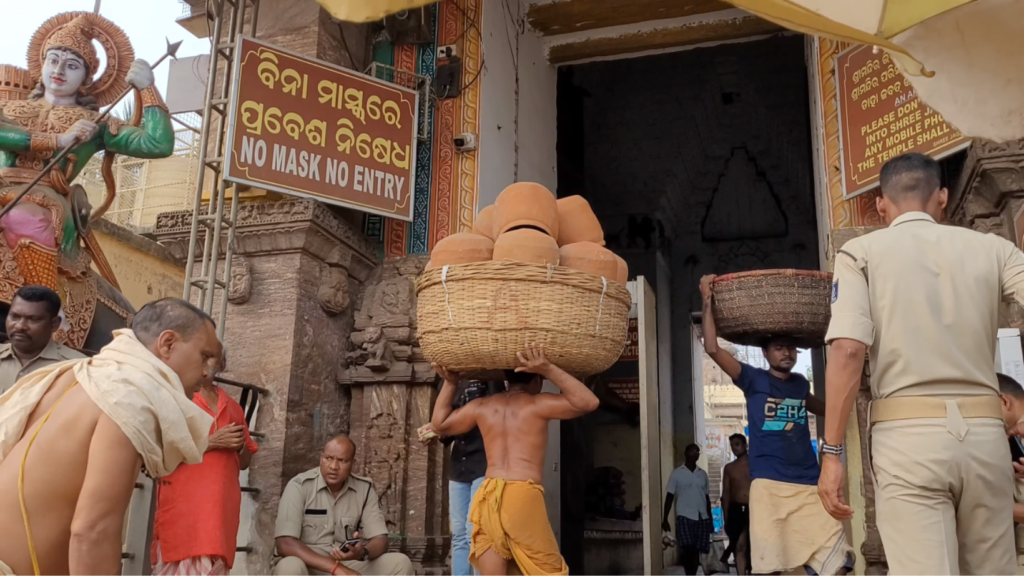
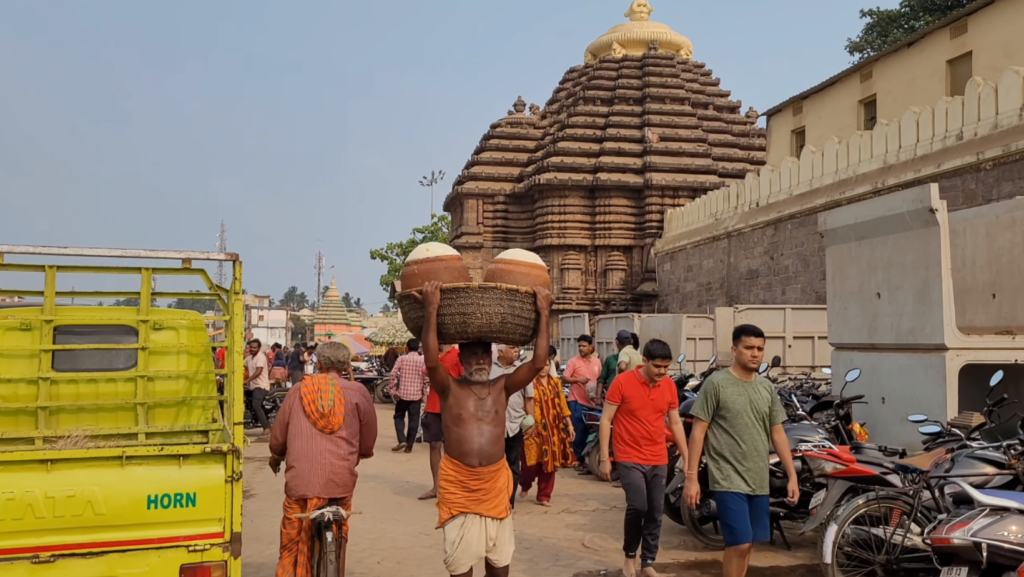
Architecture of Shree Jagannath Temple Puri
Lord Jagannath Puri Temple, built in the Kalinga architectural style, stands at the center of the inner courtyard on a raised platform. It comprises four parts: Vimana, Jagamohana, Nata Mandapa, and Bhoga Mandapa. Shrine features two structures – Rekha Deula and Pitha Deula.
Vimana, with its Pancharatha ground plan and curvilinear spire (Shikhar), houses the deities on a stone pedestal called Ratna Singhashana. Surrounded by two concentric walls, the inner wall is known as ‘Kurma Prachira’ and the outer, 20-24 feet high, is ‘Meghanada Prachira’.
The outer wall has four gates: Singha Dwara (east), Vyaghra Dwara (west), Hastidwara (north), and Aswadwara (south). Premises also include small temples, elevated platforms, seven wells, two gardens (Nilachala Upabana and Koili Baikuntha), a kitchen, and a sacred banyan tree.
Also Read: Four Gates of Puri Jagannath Temple: Their True Significance
Jagannath Temple Inside (Bhitara Bedha)
Inside the Jagannath Temple, there are as many as 76 sacred small temples, with some of the most important ones being:
Vimala Temple
Believed to be the oldest shrine in the inner compound, this famous Shakti Peeth houses an idol of the four-armed Goddess Vimala. One hand holds a Kalasa (Jar), two others hold an Aksamala (Rosary) and a human figure, and the fourth is in Varada Mudra (pose). Prasad offered to Lord Jagannath is first offered to Goddess Vimala, only then it is called Mahaprasad.
Agneeswara Temple
This temple is considered the guardian of the fire in the temple kitchen.
Satya Narayan Temple
Housing a four-armed granite idol of Shree Narayan, this temple features a disc in one hand, a conch and mace in the other two, and the fourth hand in Abhaya Mudra.
Lakshmi Temple
Built by the Ganga Dynasty in the 12th-13th century AD, this temple houses an idol of Goddess Gajalakshmi with four arms. Top two hold elephants, while the lower two represent Varada and Abhaya poses.
Shree Nrusimha Temple
Constructed prior to the Jagannath Temple, this temple is dedicated to Lord Nrusimha. It features Pancharatha Rekha Deula architecture but lacks a prayer hall, housing a small idol of the deity.
Surya Temple
Dedicated to the Sun God, this temple houses an image of the Sun, believed to have been brought by King Narasimha Deva of the Bhoj Dynasty from the Konark Temple.
Bata Ganesha Temple
Located below the sacred banyan tree called Kalpabata, this temple is dedicated to Lord Ganesha.
Nrutta Ganapati Temple
Built in the 13th century AD, this temple houses an eight-armed idol of Lord Ganesha in a dancing pose.
Bhubaneswari Temple
Temple houses an idol of Goddess Saraswati along with images of Goddesses Sasthi, Savitri, and Gayatri.
Kalpabata
A huge banyan tree on the southern side of the temple, it is believed that devotees who circumambulate the tree and step on its shadow attain Kesavalaya, the abode of Lord Vishnu.
Kanchi Ganesha
Dedicated to Lord Ganesha in the form of Bhanda Ganesha, this shrine houses a four-armed idol of the deity and an image of his consort on his lap. The image is believed to be a tantric image brought by Gajapati Purushottama Dev from Kanchi.
Mukti Mandapa
Platform has 16 pillars and measures 38 feet in both width and length. Only a few priests from specific villages, Deula Purohita, Dandai Sanyasis, Jagadguru Sankarcharya, and Rajgurus are entitled to sit on this platform.
Also Read: Gundicha Temple Puri: History, Timings, Photos!
Outer Compound (Bahara Bedha)
Outer compound of the Jagannath Temple features about 45 significant parts, including:
Roshaghara (Kitchen)
Believed to be the largest kitchen of its kind in the world, Roshaghara features about 250 Chulis (hearths). Cooking here is done traditionally using earthen pots and burning charcoal. Only the Suaras (Servitors) and their assistants are allowed inside. Kitchen comprises 32 rooms, each 20 feet high, 100 feet wide, and 150 feet long. Around 600 chefs and 400 assistants cook daily.
Ananda Bazaar
Area is where Mahaprasad is sold, along with other sacred sweet delicacies of Puri. Devotees can also sit and eat Mahaprasad in a dedicated space within this part of the premises.
Aruna Sthamba
A monolithic pillar with sixteen sides, Aruna Sthamba stands 34 feet tall on the eastern side of the main temple. It was brought from the Konark Temple by King Dibyasingha Deva.
Baisi Pahacha
Meaning “22 steps,” Baisi Pahacha refers to the flight of stairs leading from the outer compound to the inner compound of the temple. Currently, only 17 steps are visible due to later constructions. It is believed that sitting on these steps is a sacred duty for devotees.
Patitapabana
A single image of Lord Jagannath, called Patitapabana, is carved on the Singha Dwara. Image allows devotees who cannot enter the temple to still have darshan of the Lord.
Snana Mandapa
Pavilion is where the bathing festival of the main deities is performed.
Also Read: Pancha Tirtha of Puri: Explore These 5 Sacred Spots!
Intresting Facts About the Shree Jagannatha Temple
There are some interesting facts for visitors to witness at Shree Jagannath Temple in Puri that are sure to astound them.
Witnessing the Changing of the Flag Ritual
- Every evening at sunset, the flag mounted on top of the main temple is changed. Ritual has been performed for over 800 years, with the responsibility assigned to a family of priests by the Gajapati King. One priest climbs the temple walls barefoot and with bare hands, without any equipment, to change the flag. Height of the temple is said to be equivalent to a 45-storey building.
Notice the Temple’s Shadow
- One fascinating thing about the temple is that, no matter what time of day it is, its shadow never falls on the ground. This mystery has been attracting visitors for years.
Look at the Sudarshan Chakra
- Nilachakra or Sudarshan Chakra, mounted on top of the temple, appears the same from all directions when viewed from below.
Observe the Sky Above the Temple
- You’ll notice something strange at the temple—no birds fly over it, and you won’t see any airplanes above the temple either. Unusual phenomenon is another reason why the temple is so special.
Experience the Silence of the Sea
- An interesting observation after entering the gates of the shrine is that the sound of the sea waves is completely lost, and can only be heard after exiting the temple.
Opposite Breeze
- During the day, the breeze blows from land to sea, and in the evening, it reverses direction, blowing from sea to land. This is contrary to the normal pattern observed worldwide.
Magical Method to Cook
- In the temple kitchen, approximately 250 hearths are used to prepare 56 food items for nearly 20,000 people daily, and up to 50,000 on special occasions. Remarkably, not a single bite goes to waste. Most fascinating aspect is that earthen pots are stacked on top of each other, but the pot at the top cooks first. Visitors are not allowed in the kitchen, and the cooking technique remains a closely guarded secret known only to the servitors.
Shopping
Beyond exploring the temple, visitors can enjoy shopping for local handicrafts and various items related to Lord Jagannath, as well as indulging in local delicacies at the market on the Grand Road. They can relax in the newly built garden just outside the temple, which enhances the overall charm of the area.
Jagannath Temple Located
Jagannath Temple located in Puri, Odisha.
Jagannath Temple Puri Timings
| Rituals | Timings |
| Dwarpitha and Mangal Aarati | 5:00 am |
| Mailam | 6:00 am |
| Abakash | 6:00 am to 6:30 am |
| Mailam | 6:45 am |
| Sahanamela | 7:00 am to 8:00 am |
| Beshalagi | 8:00 am |
| Rosha Homa Surya Puja and Dwarapal | 8:00 am to 8:30 am |
| Gopala Ballava Puja | 9:00 am |
| Sakala Dhupa(Morning food offering)Mailam | 10:00 am |
| Mailam & Bhoga Mandap (2 to 3 times a day) | Madhyanha Dhoop Sandhya Dhoop |
| Madhyanha (Afternoon food offering) | 11:00 am to 1:00 pm |
| Madhyanha Pahudha | 1:00 pm to 1:30 pm |
| Sandhya Aarati | 5:30 pm |
| Sandhya Dhupa | 7:00 pm to 8:00 pm |
| Mailam and Chandana lagi | 8:30 pm |
| Badashringara Vesha | After Chanadana Lagi |
| BadaShringar Laga Bhoga | 9:30 pm to 10:30 pm |
| Khata Seja Lagi and Pahuda | 12:00 am (Midnight) |
Jagannath Temple near me
- Konark Sun Temple – 35.8 km
Known for its ancient temples and the UNESCO World Heritage Site, the Sun Temple. - Raghurajpur Artist Village – 10 km
Famous for its Pattachitra paintings and traditional crafts. - Chilika Lake – 50 km
Asia’s largest brackish water lagoon, known for bird watching and boating. - Pipili – 36 km
Renowned for its applique work and vibrant handicrafts. - Astaranga Beach – 60 km
A serene beach perfect for a peaceful getaway. - Bhubaneswar – 60 km
The capital city of Odisha, known for its temples and urban attractions. - Cuttack – 90 km
Known for its historical significance and silver filigree work.
Also Read: Puri Matha List: Affordable Stay Options!
Visiting Tips for Shree Jagannath Temple, Puri
- Entry Restrictions: Only Hindus are allowed to enter the temple.
- Prohibited Items: Footwear, leather articles, mobile phones, and cameras are not permitted inside.
- Storage Facilities: Free mobile phone and shoe stands are available on the premises.
- Medical Services: Ambulance and first-aid services with experienced doctors are available.
- Water Facilities: Clean drinking water is provided within the complex.
- Accessibility: Free battery-operated vehicles are available for senior citizens and physically challenged persons from Market Square to the North Gate/Main Gate. Wheelchair and ramp facilities are also provided.
Also Read: Top 11 Famous Temple in Puri
FAQs
Puri jagannath temple established year?
According to epigraphical records, the Shree Jagannatha Temple in Puri, Odisha, was built between 1135 and 1150 CE during the reign of King Anantavarman Chodaganga Deva.
Puri jagannath temple famous for?
Puri Jagannath Temple is famous for its annual Rath Yatra festival, where the deities are taken out on grand chariots. It is also renowned for its unique rituals, the sacred Mahaprasad, and its architectural marvels, including the Nilachakra and the absence of the temple’s shadow on the ground.
Puri jagannath temple idol.
Idol of Lord Jagannath at Puri is a unique wooden figure with large round eyes and a symmetric face, notably lacking hands and legs. Made from sacred wood known as daru brahma, the idol is ceremoniously replaced every 12 or 19 years through the Nabakalebara ritual.
Puri jagannath temple in which state?
Puri Jagannath Temple is located in the state of Odisha, India.
How old is the Jagannath Temple?
The Jagannath Temple dates back to the 12th century, built by King Ananta Varman Chodaganga Deva of the Ganga Dynasty.
Who are the deities worshipped in the Jagannath Temple?
The primary deities are Lord Jagannath, his brother Lord Balabhadra, and his sister Goddess Subhadra.
Are there any specific dress codes or rules for visiting the Jagannath Temple?
Yes, visitors are expected to dress modestly. Non-Hindus are not allowed to enter the temple premises.
Can non-Hindus visit the Jagannath Temple?
No, only Hindus are permitted to enter the temple.
What is Mahaprasad?
Mahaprasad is the sacred food offered to Lord Jagannath, first offered to Goddess Vimala before being distributed to devotees.
What is the Nabakalebara ritual?
Nabakalebara is a unique ritual where the wooden idols of the deities are replaced every 12 or 19 years.
